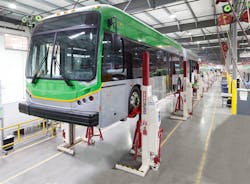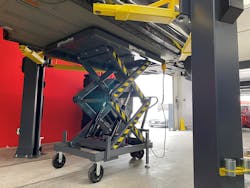Diesel and gasoline will remain the mainstays of the North American transportation industry for decades to come. However, it seems logical to assume that recent technological advancements on the electric vehicle (EV) front will drive some significant changes in terms of shop layout and the equipment fleets keep on hand to maintain and deploy battery-electric vehicles (BEVs).
First off, it’s worth noting why these changes will occur. Maintenance experts say that, on average, an electric truck or van has approximately 3,000 fewer moving parts than a comparable vehicle with a conventional internal combustion engine. This vast reduction in mechanical systems and components will simplify parts inventory and storage. And, from a very high level, this new operational reality will free up or transform significant amounts of shop floor “real estate” as there will be a greatly reduced, or nonexistent need for areas devoted to activities such as draining engine oil or coolant, servicing exhaust systems and cleaning diesel particulate filters (DPFs), or tearing down and rebuilding engines.
Which is not to say BEV maintenance shops will be completely alien landscapes. There will still be the need to access the underside of vehicles, for example. Suspensions, axles, wheels, and vehicle bodies will still require maintenance, as will systems like high-voltage battery systems and the advanced, highly complex onboard computing systems that will manage and direct the electricity those batteries store and dispense to the BEV’s powertrain.
The BEV shop takes shape
“Most facilities will be similar to existing conventional workshops since we are currently modifying existing bays,” said Brett Pope, director, electric vehicles, Volvo Trucks North America. He said that in these formative stages of BEV shop development, there is a high focus on safety and ensuring limited access to the high-voltage systems.
“A good training plan with focus upon safety considerations for high-voltage systems needs to be considered,” Pope added. “Volvo Trucks has developed a Volvo EV Certified Dealer program for dealers to ensure the safety of everyone working around a Volvo VNR Electric. It will ensure the understanding of the charging infrastructure needed to charge heavy-duty EVs, shop requirements, and EV training tailored to the service, parts, and sales departments. This provides the basis for a blueprint that can be used for other dealership locations.”
Looking at the medium-duty side of the equation, Jim Groat, Ford customer service engineering manager, said most repairs to Ford electric vehicles can be completed with standard shop equipment within existing shop layouts. High-voltage battery repair requires unique tools, equipment, and training.
“Removing high-voltage batteries will require a two-post surface lift or an inground lift with at least 80 inches between the posts,” Groat said. “High-voltage batteries are very large, covering almost the full width of the vehicle and extending from front to rear axle—and this entire area needs to be clear to remove the battery. While performing routine maintenance on an electric vehicle will not require any more bay space than doing the same work on a similar vehicle with an internal combustion engine, replacing a high-voltage battery is space-intensive. Shops planning to do this work will need to allow for an area of approximately eight feet by six feet for moving the battery off the lifting table, storing the dunnage with the new battery, and swapping the new battery with the old one in the dunnage. Shops will also need to consider where they will store the large battery lifting table. Ford’s required table is approximately 100 inches by 40 inches. We also recommend 240V 14-50 NEMA outlets to charge the vehicles and to facilitate using the vehicle charging cable for diagnostics. EVSE (electric vehicle supply equipment) wall chargers are also recommended for charging the vehicles.”
Depending on the type of BEV and OEM, shop layouts may need to be altered, said Todd Michalski, vice president of sales and marketing for Gray Manufacturing Co. “For example, some EV transit buses have large battery packs on the side and roof of the vehicle. These packs are behind side panels that need to be removed and then the packs are taken out by forklift. Shops will need ample space between bays for the removal of these packs from the side of buses. Shops will also need ceiling height to allow for the removal of the packs from the roof.”
Still, much will remain the same as it is today. Scott Bolt, vice president of product management at Noregon, said that a lot of the new equipment that shops will invest in will just be voltage-proof versions of the tools they use currently.
“Technicians will still rely on the screwdrivers, wrenches, and ratchets they do today, but each will include an insulated barrier. High-voltage gloves will be a requirement for working on electric vehicles,” Bolt said. “Gloves and other PPE (personal protective equipment) will undergo routine testing to ensure it meets current standards or be immediately replaced if it is no longer deemed a safe option.”
Additionally, remaking the shops may provide new revenue streams or business opportunities for fleets willing to think about the changes EVs will bring to the current transportation system and associated infrastructure, said Jeff Hudnut, EV product manager, Bosch Automotive Service Solutions.
“Installing EV chargers and cables serves as one major opportunity for workshops today,” he explained. “As the EV population continues to grow, new customers will likely be drawn in by shops offering EV charging services. A quick, safe, and convenient way to charge EVs can encourage new customers to visit and take advantage of the services your shop offers. Once public EV charging stations have been installed in your shop, it’s easy for shop owners to then upload that information to community maps—allowing these chargers to act as a beacon for drivers who may be searching for EV charging stations nearby.”
Modular vehicle designs and new ways to lift
With the growing use of electric vehicles, several service and maintenance considerations must be addressed, noted Peter Bowers, technical sales support manager at Stertil-Koni. These include removal of wheel drive motors and removal of battery packs. In addition, EVs will likely require fewer fluid changes and brake replacements. At the same time, they will also necessitate new repair tasks, such as inspecting and/or removing batteries, programming, software upgrades, battery coolant maintenance, and more.
“Thanks to federal regulations, commercial EV dimensions will not vary much, if at all, from the current range of petrol-based OTR (over the road) vehicles,” Bowers added. “This is good news for shop owners seeking to service EVs, as garage entries and bay dimensions are unlikely to require modification to accommodate EVs versus their petrol-powered counterparts.”
While the dimensions remain largely unchanged, Bowers said the new generation of EVs will bring their own unique servicing challenges.
“The advent of the EV drivetrains brings with them a host of new drivetrain components, requiring special consideration as it relates to vehicle lifting for maintenance,” he explained. “Shops utilizing wheel-engaging vehicle lifts, such as mobile column lifts and platform lifts, will not see a change in their safe lifting practices. That said, raising heavy-duty electric-powered vehicles with inground lifts may require alternate contact point adapters. The enormous and relatively sensitive batteries that power commercial vehicles are typically located on the undercarriages of these trucks and buses. And once raised, the next challenge becomes servicing these new drivetrain components. Battery packs, thermal management systems, and drive motors must be accessible at both the wheel-end and undercarriage frame, requiring a new age of equipment designed exclusively to handle these unique EV sub-assemblies.” Bowers confirmed shops will need to continually evaluate tool and specialty equipment needs as EV technology progresses.
Jeff Kritzer, executive vice president, BendPak, believes that most North American fleets will gradually add electric vehicles while continuing to run internal combustion vehicles for many years. And with that reality in mind, he said Bendpak engineers are designing the company’s SL2EVT electric-hydraulic lift table to not only be perfectly suited for EV battery pack replacement but to serve as a multi-functional scissor lift that can handle a wide range of jobs on any vehicle in the fleet, regardless of powertrain.
And they’re not alone. Mohawk Lifts has also designed its ST 2000 scissor lifting table in a way that allows technicians to remove and install conventional powertrain components such as engines, transmissions, transaxle assemblies, and rear ends, as well as large electric vehicle batteries. It also serves as a worktable where components can be lowered to a convenient work height for repairs.“To remove an EV battery pack, a fleet will need a vehicle lift that has sufficient rated load capacity to handle the vehicle, lift arms that can reach the OEM-recommend lifting points, and the proper lift adapters,” Kritzer said. “A two-post surface lift with [a] 10,000-pound capacity is sufficient for the electric cars currently on the market and the pickup trucks and vans that have been announced, as long as it’s properly equipped. Fleets will want to also purchase a lift table for use under the vehicle lift. The table eliminates any manual lifting or lowering of the battery pack and makes it easier to move it around the shop. The table securely supports the battery throughout the replacement process.”
Just like fleets need the proper tools and equipment to drop a transmission or remove other heavy drivetrain components from vehicles with internal combustion engines, those that will be performing their own service on BEVs need to equip themselves to safely and efficiently remove and install battery packs that weigh more than 1,000 lbs, Kritzer added. He said to help with these new BEV design characteristics, Bendpak’s SL24EVT vehicle lift features 16 recessed anchoring locations for accommodating a variety of modular fixtures, adapters, and accessories. Each can be repositioned or removed as applications dictate.
“The lift’s telescoping arm kit provides multi-configurable support of large, heavy, and awkward vehicle components,” Kritzer said, “while the multi-point adapter safely supports components like axles, fuel tanks, transfer cases, transmissions, and bumpers. The optional tilt-deck makes it possible to tilt the table surface side-to-side or fore and aft for more precise aligning of electric batteries, engine and drivetrain assemblies, fuel tanks, and more. Adjustable Accu-Point support fixtures are independently adjustable arms that can be adapted to nearly any transmission, drivetrain, or vehicle subframe shape. The universal deck mount kit features a center support pin that adapts to virtually any competitive transmission jack heads, drivetrain adapters, and fuel tank supports.”
BEVs will require fleets to think about their maintenance and repair shops in new ways. And, of course, some changes will be required in order to meet the demands these new vehicles will place on technicians and fleet managers alike. The good news is that BEVs are trucks and vans with more in common with today’s internal-combustion vehicles than differences. There will be an adjustment as fleets gear up to service BEVs. But at the end of the day, the mission and the focus of the maintenance shop will remain the same: Keep the wheels turning and the trucks and vans earning.





